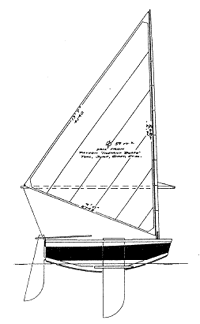BRICK
Excerpted from "Boats
with an Open Mind" by Phil Bolger
 Brick - 8' 0" X 4' 0"
Brick - 8' 0" X 4' 0" |
Brick started as an exercise
in how much boat could be built out of three 4 x 8-foot sheets
of plywood. It's a simple pleasure to come out even with no scrap
left over. I try not to let this game become an obsession: there's
an 8 x 32-inch rectangle here for which I didn't strain to find
a place.
She's practically a scaled-up
Tortoise Punt (6 feet 6 inches by 3 feet 2 inches, said with a
little malice to be my best design). The sides are too high to
row comfortably, but she'll carry four men and a big, frightened
dog, with plenty of buoyancy left, still able to sail though with
lots of noisy waves.
Built of 1/4-inch plywood
as specified, she is flimsy. I had a half-joking letter from a
builder describing the distortions in her shape and her eventual
disintegration as he and his crew hiked out to drive her. I retorted
(with a bad conscience, as I'd totaled a Tortoise the same way)
that since driving her wouldn't make her go faster, on account
of bogging down in her own waves, there was no excuse for breaking
her up. Brick would behave perfectly built of 1/2-inch plywood
and slathered with epoxy fillets. That would make her rugged,
but a lot more expensive and twice as heavy to carry around, whereas
the disposable version will last a long time with humane handling.

It's disconcerting that
these box boats do everything better than elaborately modeled
boats of the same overall dimensions, if they both have to carry
the same load. Rounding or tapering takes away volume; the boat
settles deeper in the water and makes deeper, steeper waves. It's
possible that running the bottom straight back to a perfectly
rectangular stern would increase capacity more than resistance.
The deeper transom would fit on the stipulated plywood if the
rudder were made shallower (which it could stand), and the quarter
knees displaced by the unrockered after sides would just use up
that leftover rectangle.

A good reason for the rockered
stern is that she's designed to drive stern-first under power.
The motor is mounted on the raked bow transom where it doesn't
interfere with the rudder or foul the mainsheet. The side-stepped
mast leaves the centerline motor mount clear. With rudder shipped
or tiller lashed, and the sail rolled up, she goes backward as
fast as forward; that is, not very fast.

The photo shows Bemie Wolfard's
two Bricks pinned in tandem on a central spacer to make an 18-foot
schooner, vastly roomy. The amalgam is clumsy to handle, but for
a family outing it conjured up some pleasant scenarios. The central
unit, Grout, was decked watertight to stow picnicking supplies,
and the two dinghies could be freed in a few minutes to sail separately.
The aggregate is much faster and more stable than the
separated components.

|

